JEE Main Previous Year Questions (2025): Permutations and Combinations | Chapter-wise Tests for JEE Main & Advanced PDF Download
[JEE Mains MCQs]
Q1: The total number of three-digit numbers, divisible by 3, which can be formed using the digits 1 , 3 , 5 , 8 , if repetition of digits is allowed, is:
(a) 21
(b) 22
(c) 18
(d) 20
Ans: (b)
The number of three-digit numbers divisible by 3 by considering the possible sums of digits that are divisible by 3. Your approach is as follows:
1. Sum of digits is 3: (1 , 1 , 1) - 1 possible number
2. Sum of digits is 9: (1 , 3 , 5) and (3 , 3 , 3) -
Let's consider the cases separately:
a. Sum of digits is 9: (1 , 3 , 5) For this case, we can arrange the digits in 3! ways : 135, 153, 315, 351, 513, and 531.
b. Sum of digits is 9: (3 , 3 , 3) For this case, since all the digits are the same, there is only 1 possible number : 333.
Now, the total number of possible numbers when the sum of digits is 9 is :
3 ! + 1 = 6 + 1 = 7
3. Sum of digits is 12: (1 , 3 , 8) - 3! possible numbers
4. Sum of digits is 15: (5 , 5 , 5) - 1 possible number
5. Sum of digits is 18: (5 , 5 , 8) - 3!/2! possible numbers (since 5 is repeated)
6. Sum of digits is 21: (5 , 8 , 8) - 3!/2! possible numbers (since 8 is repeated)
7. Sum of digits is 24: (8 , 8 , 8) - 1 possible number
Adding up the possible numbers for each case, we get:
So, there are a total of 22 three-digit numbers divisible by 3 that can be formed using the digits 1, 3, 5, 8 with repetition allowed.
Q2: All words, with or without meaning, are made using all the letters of the word MONDAY. These words are written as in a dictionary with serial numbers. The serial number of the word MONDAY is:
(a) 324
(b) 328
(c) 326
(d) 327
Ans: (d)
Apologies for the confusion earlier. Let's correct the calculation:
The letters of "MONDAY" arranged in alphabetical order are: A, D, M, N, O, Y.
Fix A as the first letter, we can arrange the remaining 5 letters in 5! ways = 120 ways.
Fix D as the first letter, we can arrange the remaining 5 letters in 5! ways = 120 ways.
So far, we have 120 (for A) + 120 (for D) = 240 words.
Now, let's proceed with words starting with M:
Fix MA as the first two letters, we can arrange the remaining 4 letters in 4! ways = 24 ways.
Fix MD as the first two letters, we can arrange the remaining 4 letters in 4! ways = 24 ways.
Fix MN as the first two letters, we can arrange the remaining 4 letters in 4! ways = 24 ways.
Now, we have 240 (for A and D) + 24 (for MA) + 24 (for MD) + 24 (for MN) = 312 words.
After MN, we consider words that start with MO:
Fix MOA as the first three letters, we can arrange the remaining 3 letters in 3! ways = 6 ways.
Fix MOD as the first three letters, we can arrange the remaining 3 letters in 3! ways = 6 ways.
Adding these to the total, we have 312 (previous total) + 6 (for MOA) + 6 (for MOD) = 324 words.
Next, we consider words that start with 'MON'. The word 'MONDAY' comes after 'MONAD' in dictionary order, so:
Fix 'MONA' as the first four letters. The remaining 2 letters ('D' and 'Y') can be arranged in 2! ways, which gives us 2 more words: 'MONADY' and 'MONAYD'.
So, we have 324 (previous total) + 2 (for 'MONADY' and 'MONAYD') = 326 words.
Finally, we have the word 'MONDAY' itself, which is the 327th word.
Q3: The number of five digit numbers, greater than 40000 and divisible by 5 , which can be formed using the digits 0 , 1 , 3 , 5 , 7 and 9 without repetition, is equal to :
(a) 132
(b) 72
(c) 120
(d) 96
Ans: (c)
Since the five-digit number must be greater than 40000, the only options for the first digit are 5, 7, or 9. That leaves 3 remaining choices for the first digit.
Since the number has to be divisible by 5, the last digit must be 0 or 5. If the first digit is 5, the last digit can only be 0, since digits cannot be repeated. If the first digit is 7 or 9, the last digit can be 0 or 5, so there are 2 choices.
Five possible configurations for the first and last digits:
- 5xxx0
- 7xxx0
- 7xxx5
- 9xxx0
- 9xxx5
For each of these configurations, there are three places in the middle that can be filled with the remaining 4 unused digits.
Since repetition isn't allowed, there are 4 options for the second digit, 3 for the third, and 2 for the fourth, which can be represented as 4P3, or permutations of 4 items taken 3 at a time. This is equal to 4× 3 × 2 = 24.
So, for each of the 5 configurations, there are 24 ways to arrange the middle three digits. Therefore, the total number of five-digit numbers that meet the criteria is 5 × 24 = 120.
Q4: If the letters of the word MATHS are permuted and all possible words so formed are arranged as in a dictionary with serial numbers, then the serial number of the word THAMS is :
(a) 103
(b) 104
(c) 102
(d) 101
Ans: (a)
To solve this problem, we start by finding the number of permutations before we reach a word that begins with T.
We have 5 letters in the word MATHS. If we fix the first letter, there are 4! (=4×3×2×1=24) ways to arrange the remaining letters.
The letters before T in alphabetical order are A, H, M, and S. For each of these 4 letters, there are 4! ways to arrange the rest of the word, giving 4×4! = 96 words that come before any words starting with T.
Then, in the section of words that start with 'T', we start with 'TA'. There are 3 remaining letters after 'TA', hence the permutations for words that start with 'TA' are (5-2)!=3!=6.
So, the total permutations for all words that come before 'TH' is 96 + 6 = 102.
Now, we need to count the words that come before 'THAMS'. After 'TH', the letters left are 'AMS'. Arranged in dictionary order, they would be 'AMS', 'ASM', 'MAS', 'MSA', 'SAM', 'SMA'. So, 'THAMS' is the first word in the 'TH' category, so it is the 103rd word overall when counting from the beginning.
So, the correct answer is 103, which corresponds to Option A.
Q5: The number of triplets (x , y , z) , where x , y , z are distinct non negative integers satisfying x + y + z = 15 , is :
(a)136
(b) 80
(c) 92
(d) 114
Ans: (d)
We have, x + y + z = 15
Total number of solution 

Now, we need to exclude the solutions where two of (x, y , z) are the same.
1) For the case x = y ≠ z :
2x + z = 15
The solutions are :
x = 0 , z = 15
x = 1 , z = 13
x = 2 , z = 11
x = 3 , z = 9
x = 4 , z = 7
x = 5 , z = 5 (Not valid as all are the same)
x = 6 , z = 3
x = 7 , z = 1
Out of these, 7 are valid.
Similarly, for the cases x = y ≠ z and z = x ≠ y , there will be 7 valid solutions for each, so a total of 7 × 3 = 21 solutions where two of the variables are equal.
Thus, the number of triplets where all are distinct is:
136 − 21 = 115
There is one solution in which x = y = z
Required answer = 136 - 21 - 1 = 114
Q6: Eight persons are to be transported from city A to city B in three cars of different makes. If each car can accommodate at most three persons, then the number of ways, in which they can be transported, is:
(a) 560
(b) 1680
(c) 3360
(d) 1120
Ans: (b)
Let C1 , C2 and C3 be the three cars in which 8 person are to be transported from city A to city B.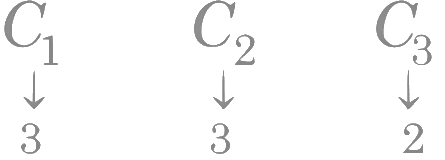 Let the number of persons transported in cars C1 , C2 and C3 are 3, 3 and 2 respectively.
Let the number of persons transported in cars C1 , C2 and C3 are 3, 3 and 2 respectively.

Q7: If the number of words, with or without meaning, which can be made using all the letters of the word MATHEMATICS in which C and S do not come together, is (6 !) k , then k is equal to :
(a) 5670
(b) 1890
(c) 2835
(d) 945
Ans: (a)
Total number of words 
Number of words in which C and S are together
So, required number of words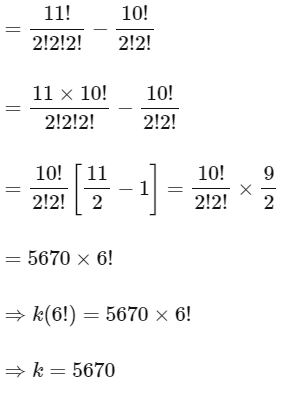
Q8: The number of arrangements of the letters of the word "INDEPENDENCE" in which all the vowels always occur together is:
(a) 16800
(b) 14800
(c) 18000
(d) 33600
Ans: (a)
In the given word,
vowels are : I, E, E, E, E
Consonants are : N, D, P, N, D, N, C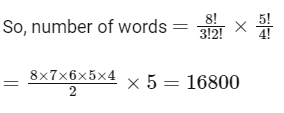
Concept:
Out of n objects, if r things are same, so number of ways = n!/r!
Q9: The number of ways, in which 5 girls and 7 boys can be seated at a round table so that no two girls sit together, is :
(a) 720
(b) 7(360)2
(c)7(720)2
(d)126 (5)2
Ans: (d)
We have,
Number of girls = 5
Number of boys = 7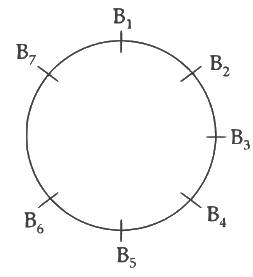 So, number of ways of arranging boys around the table = 6! and 5 girls can be arranged in 7 gaps in 7P5 ways.
So, number of ways of arranging boys around the table = 6! and 5 girls can be arranged in 7 gaps in 7P5 ways.
∴ Required no. of ways = 6! × 7P5 = 126 × (5!)2
Q10: Let the number of elements in sets A and B be five and two respectively. Then the number of subsets of A × B each having at least 3 and at most 6 elements is:
(a) 782
(b) 772
(c) 752
(d) 792
Ans: (d)

⇒ 5 × 2 = 10
So, number of subsets having elements = 10C3
Number of subsets having elements = 10C4
Number of subsets having elements = 10C5
Number of subsets having elements = 10C6
∴ No. of subsets 

Q11: All the letters of the word PUBLIC are written in all possible orders and these words are written as in a dictionary with serial numbers. Then the serial number of the word PUBLIC is :
(a) 578
(b) 576
(c) 580
(d) 582
Ans: (d)
Given word is PUBLIC.
Alphabetical order of letters is BCILPU. So, number of words start with letter.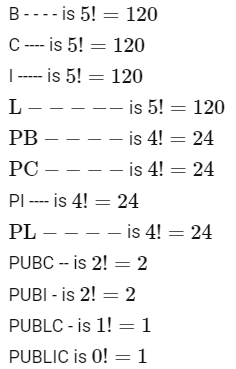
∴ Serial number of the word PUBLIC
Q12: The value of 
(a) 
(b) 
(c) 
(d) 
Ans: (d)


Q13: The number of ways of selecting two numbers a and b , a ∈ {2 , 4 , 6 , … . , 100 } and b ∈ {1 , 3 , 5 , … . . , 99} such that 2 is the remainder when a + b is divided by 23 is :
(a) 186
(b) 54
(c) 108
(d) 268
Ans: (c)
λ = 0 , 1 , 2 , ...., but λ cannot be even as a + b is odd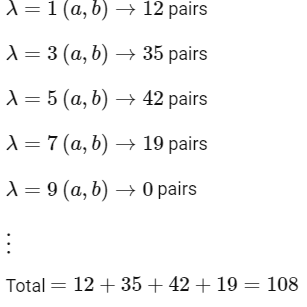
Q14: The letters of the word OUGHT are written in all possible ways and these words are arranged as in a dictionary, in a series. Then the serial number of the word TOUGH is :
(a) 79
(b) 84
(c) 89
(d) 86
Ans: (c)
Lets arrange the letters of OUGHT in alphabetical order.
G, H, O, T, U
Words starting with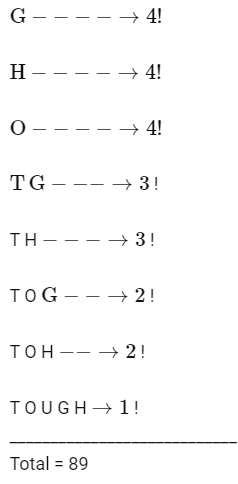
Q15: The number of 3 digit numbers, that are divisible by either 3 or 4 but not divisible by 48, is :
(a) 400
(b) 472
(c) 507
(d) 432
Ans: (d)
Number divisible by 3 = 300
Number divisible by 4 = 225
Number divisible by 12 = 75
Number divisible by 48 = 18
Total required number = 300 + 225− 75 − 18 = 432
∴ Option (1) is correct.
Q16: The number of numbers, strictly between 5000 and 10000 can be formed using the digits 1, 3, 5, 7, 9 without repetition, is :
(a) 120
(b) 6
(c) 72
(d) 12
Ans: (c)
Numbers between 5000 & 10000
Using digits 1, 3, 5, 7, 9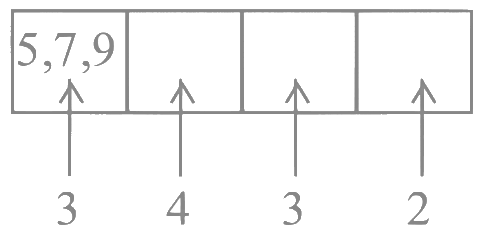 Total Numbers = 3 × 4 × 3 × 2 = 72
Total Numbers = 3 × 4 × 3 × 2 = 72
Q17: 
(a) 51C4 - 45C4
(b) 51C3 - 45C3
(c) 52C3 - 45C3
(d) 52C4 - 45C4
Ans: (d)
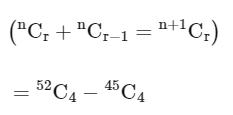
Q18: The number of integers, greater than 7000 that can be formed, using the digits 3, 5, 6, 7, 8 without repetition is :
(a) 48
(b) 120
(c) 168
(d) 220
Ans: (c)
Four digit numbers greater than 7000 = 2 × 4 × 3 × 2 = 48
Five digit number = 5 ! = 120
Total number greater than 7000 = 120 + 48 = 168
Q19: The number of square matrices of order 5 with entries from the set {0, 1}, such that the sum of all the elements in each row is 1 and the sum of all the elements in each column is also 1, is :
(a) 125
(b) 150
(c) 225
(d) 120
Ans: (d)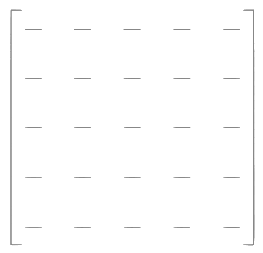 ∵ In every row and every column there would be exactly one 1 and four zeroes.
∵ In every row and every column there would be exactly one 1 and four zeroes.
Number of matrices 
[JEE Mains Numericals]
Q20: A person forgets his 4-digit ATM pin code. But he remembers that in the code all the digits are different, the greatest digit is 7 and the sum of the first two digits is equal to the sum of the last two digits. Then the maximum number of trials necessary to obtain the correct code is ___________.
Ans: 72
Let the 4-digit ATM pin code be represented by the digits abxy , where all digits are different, the greatest digit is 7, and the sum of the first two digits is equal to the sum of the last two digits: a + b = x + y.
Since the greatest digit is 7, the possible digits for the pin code are 0 , 1 , 2 , 3 , 4 , 5 , 6 , and 7.
1. Let's denote the sum of the first two digits and the sum of the last two digits as λ. Since the largest digit is 7, we can analyze different possible values for λ.
We will analyze different possible values for λ and the corresponding possible pairs of digits:
- λ = 7: The pairs of digits that have a sum of 7 are
(0 , 7) , (7, 0) , (1 , 6) , (6 , 1) , (2 , 5) , (5 , 2) , (3 , 4) , (4 , 3).
Since 7 must be present, we consider the pairs with 7: (0 , 7) , (7 , 0).
When the pair (0 , 7) is chosen, the other two digits can be any one of the remaining pairs: (1 , 6) , (6 , 1) , (2 , 5) , (5 , 2) , (3 , 4) , (4 , 3). For each of these pairs, there are 2 possible pin codes: 07xy and 07yx, where x and y are the digits from the chosen pair. In total, there are 12 possible pin codes for this case.
When the pair (7 , 0) is chosen, the other two digits can also be any one of the remaining pairs: (1 , 6) , (6 , 1) , (2 , 5) , (5 , 2) , (3 , 4) , (4 , 3). For each of these pairs, there are 2 possible pin codes: 70 xy and 70 yx, where x and y are the digits from the chosen pair. In total, there are 12 possible pin codes for this case.
So, there are 24 possible pin codes for λ = 7.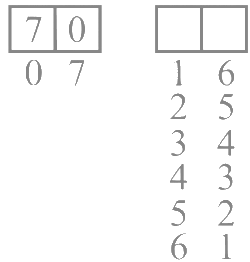 - λ = 8: The pairs of digits that have a sum of 8 are (1,7),(7,1),(2,6),(6,2),(3,5),(5,3). Since 7 must be present, we consider the pairs with 7: (1,7),(7,1).
- λ = 8: The pairs of digits that have a sum of 8 are (1,7),(7,1),(2,6),(6,2),(3,5),(5,3). Since 7 must be present, we consider the pairs with 7: (1,7),(7,1).
When the pair (1,7) is chosen, the other two digits can be any one of the remaining pairs: (2,6),(6,2),(3,5),(5,3). For each of these pairs, there are 2 possible pin codes: 17xy and 17yx, where x and y are the digits from the chosen pair. In total, there are 8 possible pin codes for this case.
When the pair (7,1) is chosen, the other two digits can also be any one of the remaining pairs: (2,6),(6,2),(3,5),(5,3). For each of these pairs, there are 2 possible pin codes: 71xy and 71yx, where x and y are the digits from the chosen pair. In total, there are 8 possible pin codes for this case.
So, there are 16 possible pin codes for λ=8.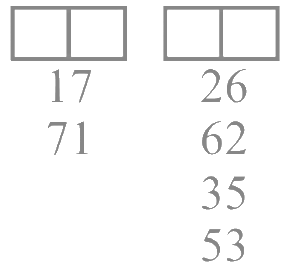 - λ = 9: The pairs of digits that have a sum of 9 are (2,7),(7,2),(3,6),(6,3),(4,5),(5,4). Since 7 must be present, we consider the pairs with 7: (2,7),(7,2).
- λ = 9: The pairs of digits that have a sum of 9 are (2,7),(7,2),(3,6),(6,3),(4,5),(5,4). Since 7 must be present, we consider the pairs with 7: (2,7),(7,2).
When the pair (2,7) is chosen, the other two digits can be any one of the remaining pairs: (3,6),(6,3),(4,5),(5,4). For each of these pairs, there are 2 possible pin codes: 27xy and 27yx, where x and y are the digits from the chosen pair. In total, there are 8 possible pin codes for this case.
When the pair (7,2) is chosen, the other two digits can also be any one of the remaining pairs: (3,6),(6,3),(4,5),(5,4). For each of these pairs, there are 2 possible pin codes: 72xy and 72yx, where x and y are the digits from the chosen pair. In total, there are 8 possible pin codes for this case.
So, there are 16 possible pin codes for λ = 9.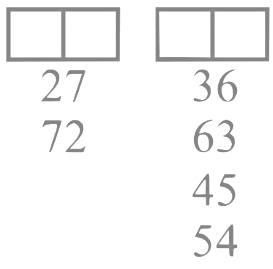 - λ = 10: The pairs of digits that have a sum of 10 are (3,7),(7,3),(4,6),(6,4). Since 7 must be present, we consider the pairs with 7: (3,7),(7,3).
- λ = 10: The pairs of digits that have a sum of 10 are (3,7),(7,3),(4,6),(6,4). Since 7 must be present, we consider the pairs with 7: (3,7),(7,3).
When the pair (3,7) is chosen, the other two digits can be any one of the remaining pairs: (4,6),(6,4). For each of these pairs, there are 2 possible pin codes: 37xy and 37yx, where x and y are the digits from the chosen pair. In total, there are 4 possible pin codes for this case.
When the pair (7,3) is chosen, the other two digits can also be any one of the remaining pairs: (4,6),(6,4). For each of these pairs, there are 2 possible pin codes: 73xy and 73yx, where x and y are the digits from the chosen pair. In total, there are 4 possible pin codes for this case.
So, there are 8 possible pin codes for λ = 10.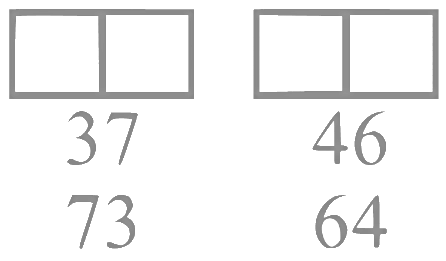 - λ = 11: The pairs of digits that have a sum of 11 are (4,7),(7,4),(5,6),(6,5). Since 7 must be present, we consider the pairs with 7: (4,7),(7,4).
- λ = 11: The pairs of digits that have a sum of 11 are (4,7),(7,4),(5,6),(6,5). Since 7 must be present, we consider the pairs with 7: (4,7),(7,4).
When the pair (4,7) is chosen, the other two digits can be any one of the remaining pairs: (5,6),(6,5). For each of these pairs, there are 2 possible pin codes: 47xy and 47yx, where x and y are the digits from the chosen pair. In total, there are 4 possible pin codes for this case.
When the pair (7,4) is chosen, the other two digits can also be any one of the remaining pairs: (5,6),(6,5). For each of these pairs, there are 2 possible pin codes: 74xy and 74yx, where x and y are the digits from the chosen pair. In total, there are 4 possible pin codes for this case.
So, there are 8 possible pin codes for λ = 11.
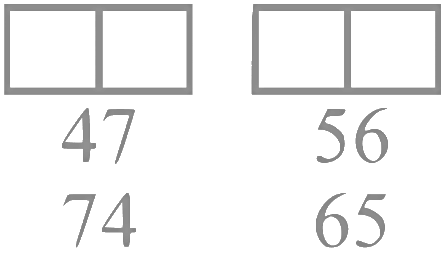 - λ = 12: The only pair of digits that have a sum of 12 is (5,7). Since 7 must be present, this case is not possible.
- λ = 12: The only pair of digits that have a sum of 12 is (5,7). Since 7 must be present, this case is not possible.
- λ = 13: The only pair of digits that have a sum of 13 is (6,7). Since 7 must be present, this case is not possible.
- λ = 14: The only pair of digits that have a sum of 14 is (7,7). Since all the digits must be different, this case is not possible.
Adding up all the possible pin codes for each value of λ, we get:
16+24+24+16+8=72
Therefore, the maximum number of trials necessary to obtain the correct code is 72.
Q21: Total numbers of 3-digit numbers that are divisible by 6 and can be formed by using the digits 1, 2, 3, 4, 5 with repetition, is _________.
Ans: 6
A number is divisible by 6 if it is divisible by both 2 and 3. A number is divisible by 2 if its last digit is even, which means it must be either 2 or 4 from the given digits. A number is divisible by 3 if the sum of its digits is divisible by 3.
(2, 1, 3), (2, 3, 4),(2, 5, 5), (2, 2, 5), (2, 2, 2)
(4, 1, 1),(4, 4, 1), (4, 4, 4), (4, 3, 5)
2, 1, 3 ⇒ 312,132
2, 3, 4 ⇒ 342,432,234,324
2, 5, 5 ⇒ 552
2, 2, 5 ⇒ 252, 522
2, 2, 2 ⇒ 222
4, 1, 1 ⇒ 114
4, 4, 1 ⇒ 414,144
4, 4, 4 ⇒ 444
4, 3, 5 ⇒ 354, 534
Total 16 numbers.
Q22: The number of seven digit positive integers formed using the digits 1, 2, 3 and 4 only and sum of the digits equal to 12 is ___________.
Ans: 413
x1 + x2 + x3 +… x7 = 12. This equation represents the number of ways to distribute 12 identical items (the sum of the digits) into 7 distinct boxes (the seven digits of the number), where each box can contain one of the numbers 1, 2, 3, or 4.
Number of solutions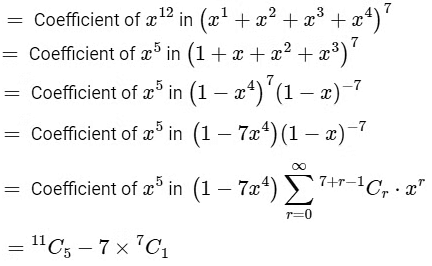
= 462 - 49 = 413
Q22: Let the digits a, b, c be in A. P. Nine-digit numbers are to be formed using each of these three digits thrice such that three consecutive digits are in A.P. at least once. How many such numbers can be formed?
Ans: 1260
The problem involves forming nine-digit numbers from three digits a, b, c which are in Arithmetic Progression (AP), used three times each, such that at least once, three consecutive digits are in AP.
We have the two possible sequences for the AP:
a, b, c
c, b, a
This shows the flexibility in ordering the three digits that are in AP in our nine-digit number.
The next step is to choose the location of this sequence of three numbers within our nine-digit number.
Since there are nine places in our number and our sequence takes up three places, we have seven different starting points for our sequence : it can start at the first place, the second place, and so on, up to the seventh place.
Therefore, the number of ways to select 3 consecutive places out of the 9 places for the AP sequence is 7.
However, we also have to account for the fact that our sequence can be in one of two orders (a, b, c or c, b, a). So, we multiply the number of starting points by 2 to get 7C1 × 2 = 14 ways to arrange the sequence within our nine-digit number.
The remaining 6 digits (two 'a', two 'b', two 'c") can be arranged in  ways.
ways.
Therefore, the total number of such nine-digit numbers is 
Q23: In an examination, 5 students have been allotted their seats as per their roll numbers. The number of ways, in which none of the students sits on the allotted seat, is _________.
Ans: 44
This problem can be solved using the concept of derangements, which is a permutation of objects where no object appears in its original position. In this case, we have 5 students who should not sit in their allotted seats.
The formula for calculating the number of derangements (also known as subfactorials) is :
Where n is the number of students, in this case, 5.
Using the formula, let's calculate the derangements for 5 students: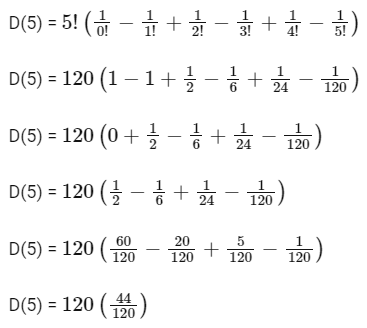
D(5) = 44
So, there are 44 ways in which none of the students sits on the allotted seat.
Q24: The sum of all the four-digit numbers that can be formed using all the digits 2, 1, 2, 3 is equal to __________.
Ans: 26664
We have, four digits are 2, 1, 2, 3.
Total numbers when 1 is at unit digit =3!/2!=3
Total number when 2 is at unit digit = 3! = 6
Total numbers when 3 is at unit digit =3!/2!=3
Sum of digits at unit place =3×1+6×2+3×3=24
∴ Required sum =24×1000+24×100+24×10+24×1
= 24 × 1111 = 26664
Q25: The number of permutations, of the digits 1, 2, 3, ..., 7 without repetition, which neither contain the string 153 nor the string 2467, is ___________.
Ans: 4898
Given that digits are 1,2,3,4,5,6,7
Total permutations =7!
Let p = Number which containing string 153
q = Number which containing string 2467
∴n(p)=5!×1
⇒n(p)=4!×1
⇒n(p∩q)=2!
∴n(p∪q)=n(q)+n(q)−n(p∩q)
=5! + 4! − 2! = 120 + 24 − 2 = 142
∴n (neither string 143 nor string 2467)
Q26: Some couples participated in a mixed doubles badminton tournament. If the number of matches played, so that no couple played in a match, is 840, then the total number of persons, who participated in the tournament, is ___________.
Ans: 16
Let, n be the total number of couples who participated in the tournament.
According to the question, 


Put n = 8 satisfied the equation.
So, n = 8
Hence, total number of players who participated in the tournament = 2 × 8 = 16
Q27: The number of 4-letter words, with or without meaning, each consisting of 2 vowels and 2 consonants, which can be formed from the letters of the word UNIVERSE without repetition is __________.
Ans: 432
Given, word is UNIVERSE
Here, vowels are E, I, U and consonants are N, R, S, V
∴ Required number of 4-letters words, with or without meaning,
each consisting of 2 vowels and 2 consonants


Q28: The number of ways of giving 20 distinct oranges to 3 children such that each child gets at least one orange is ___________.
Ans: 3483638676
Total ways without any restrictions:
There are 320 ways to distribute the oranges to the 3 children.
Number of ways one child receives no orange:
Choose 1 child out of the 3 to not receive any orange in 3C1 = 3 ways. Distribute 20 oranges to the remaining 2 children in 220 ways. However, we've included the scenarios where the 2 children each get all the oranges. So, we subtract the 2 ways where one of the two remaining children gets all the oranges. 3C1 (220 − 2)
Number of ways two children receive no orange:
Choose 2 children out of the 3 to not receive any oranges in 3C2 = 3 ways. The third child will receive all 20 oranges in 1 20 = 1 way. 3C2 × 120 = 3
Number of ways
= Total − (One child receive no orange + two child receive no orange)
3483638676
Q29: Number of integral solutions to the equation x + y + z = 21 , where x ≥ 1 , y ≥ 3 , z ≥ 4 , is equal to ____________.
Ans: 105




= 105
Q30: The total number of six digit numbers, formed using the digits 4, 5, 9 only and divisible by 6, is ____________.
Ans: 81
A number will be divisible by 6 iff the digit at the unit place of the number is divisible by 2 and sum of all digits of the number is divisible by 3.
Units, place must be occupied by 4 and hence, at least one 4 must be there.
Possible combination of 4, 5, 9 are as follows: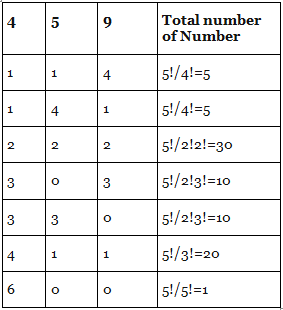 Total = 5 + 5 + 30 + 10 + 10 + 20 + 1 = 81.
Total = 5 + 5 + 30 + 10 + 10 + 20 + 1 = 81.
Q31: The number of 3-digit numbers, that are divisible by either 2 or 3 but not divisible by 7, is ____________.
Ans: 514 A = Numbers divisible by 2
A = Numbers divisible by 2
B = Numbers divisible by 3
C = Numbers divisible by 7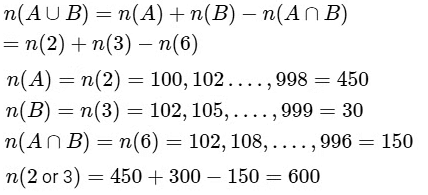
Now,
Q32: The number of words, with or without meaning, that can be formed using all the letters of the word ASSASSINATION so that the vowels occur together, is ___________.
Ans: 50400
Vowels: A,A,A,I,I,O
Consonants: S,S,S,S,N,N,T
∴ Total number of ways in which vowels come together
Q33: Let 
The number of matrices A such that the sum of all entries is a prime number p ∈ (2 , 13) is __________.
Ans: 204
Such that Σaii = 3,5,7 or 11
Then for sum 3, the possible entries are (0, 0, 0, 3), (0, 0, 1, 2),(0, 1, 1, 1).
Then total number of possible matrices = 4 +12 + 4 = 20
For sum 5 the possible entries are (0, 0, 1, 4), (0, 0, 2, 3),(0, 1, 2, 2),(0, 1, 1, 3) and (1, 1, 1, 2).
∴ Total possible matrices =12 + 12 + 12 + 12 + 4 = 52
For sum 7 the possible entries are (0, 0, 3, 4), (0, 2, 2, 3),(0, 1, 2, 4),(0, 1, 3, 3),(1, 2, 2, 2), (1, 1, 2, 3) and (1, 1,1, 4).
∴ Total possible matrices = 80
For sum 11 the possible entries are (0, 3, 4, 4), (1, 2, 4, 4),(2, 3, 3, 3),(2, 2, 3, 4).
∴ Total number of matrices = 52
∴ Total required matrices = 20 + 52 + 80 + 52 = 204
Q34: If 2n + 1Pn − 1 : 2n−1Pn = 11 : 21 , then n2 + n + 15 is equal to:
Ans: 45






Q35: Let 5 digit numbers be constructed using the digits 0, 2, 3, 4, 7, 9 with repetition allowed, and are arranged in ascending order with serial numbers. Then the serial number of the number 42923 is __________.
Ans: 2997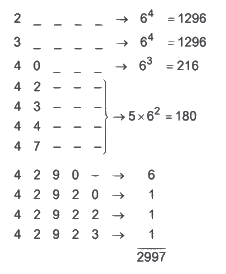
Q36: Number of 4-digit numbers that are less than or equal to 2800 and either divisible by 3 or by 11 , is equal to ____________.
Ans: 710
Numbers which are divisible by 3 (4 digit) and less than or equal to 2800
Numbers which are divisible by 11 (4 digit) and less than or equal to 2800
Numbers which are divisible by 33 (4 digit) and less than or equal to 2800
∴ Total numbers = 600 + 164 - 54 = 710
Q37: The number of seven digits odd numbers, that can be formed using all the seven digits 1, 2, 2, 2, 3, 3, 5 is ____________.
Ans: 240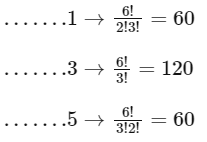
Total = 240
Q38: Number of 4-digit numbers (the repetition of digits is allowed) which are made using the digits 1, 2, 3 and 5, and are divisible by 15, is equal to ___________.
Ans: 21
We have to make 4 digit numbers using the digits, 1, 2, 3 and 5.
The unit digit of the 4 digit number will be 5.
Now, the sum (x + y + z) should be of the (3p + 1).
Therefore, the possible cases are
(x, y, z) = (1, 1, 5), (1, 1, 2), (2, 2, 3), (2, 3, 5), (3, 3, 1) and (5, 5, 3).
So, total arrangements are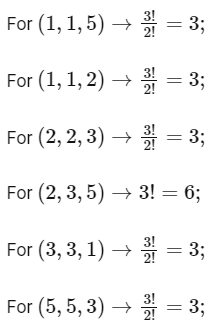
So, total number of arrangements = 3 + 3 + 3 + 6 + 3 + 3 = 21
Q39: The total number of 4-digit numbers whose greatest common divisor with 54 is 2, is __________.
Ans: 3000
gcd (a , 54) = 2 when a is a 4 digit no. And 54 = 3 × 3 × 3 × 2
So, a = all even no. of 4 digits − Even multiple of 3 (4 digits)
= 4500 − 1500
= 3000
Q40: If all the six digit numbers x1 x2 x3 x4 x5 x6 with 0 < x1 < x2 < x3 < x4 < x5 < x6 are arranged in the increasing order, then the sum of the digits in the 72th number is _____________.
Ans: 32

72th number = 245678
Sum = 32
Q41: Five digit numbers are formed using the digits 1, 2, 3, 5, 7 with repetitions and are written in descending order with serial numbers. For example, the number 77777 has serial number 1. Then the serial number of 35337 is ____________.
Ans: 1436
Descending order means from highest to lowest.
∴ Descending order of digits 1, 2, 3, 5, 7 is = 7, 5, 3, 2, 1.
(1) Number starts with 7: ∴ Total possible numbers start's with 7 are = 5C1 × 5C1 × 5C1 × 5C1 = 54
∴ Total possible numbers start's with 7 are = 5C1 × 5C1 × 5C1 × 5C1 = 54
(2) Number of starts with 5 :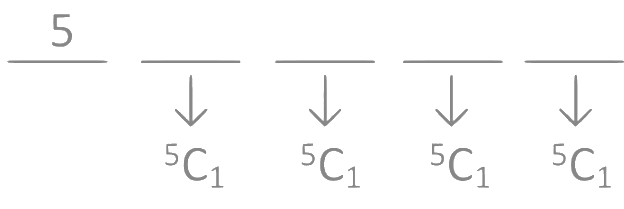 ∴ Total possible numbers start's with 5 are = 5C1 × 5C1 × 5C1 × 5C1 = 54
∴ Total possible numbers start's with 5 are = 5C1 × 5C1 × 5C1 × 5C1 = 54
(3) Number starts with 37: ∴ Total possible numbers starts with 3 and 7 are = 5C1 × 5C1 × 5C1 = 53
∴ Total possible numbers starts with 3 and 7 are = 5C1 × 5C1 × 5C1 = 53
(4) Number starts with 357: ∴ Total possible numbers starts with 357 are = 5C1 × 5C1 = 52
∴ Total possible numbers starts with 357 are = 5C1 × 5C1 = 52
(5) Number starts with 355: ∴ Total possible numbers starts with 355 are = 5C1 × 5C1 = 52
∴ Total possible numbers starts with 355 are = 5C1 × 5C1 = 52
(6) Number starts with 3537: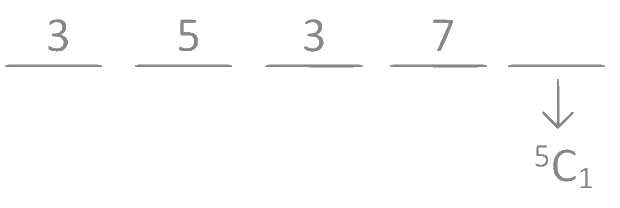 ∴ Total possible numbers starts with 3537 are = 5C1 = 5
∴ Total possible numbers starts with 3537 are = 5C1 = 5
(7) Number starts with 3535: ∴ Total possible numbers starts with 3535 are = 5C1 = 5
∴ Total possible numbers starts with 3535 are = 5C1 = 5
(8) Next number is 35337 which is the required number.
∴ Position of the number 35337 is = 54 + 54 + 53 + 52 + 52 + 5 + 5 + 1 = 1436
Q42: A triangle is formed by X-axis, Y-axis and the line 3x + 4y = 60. Then the number of points P(a, b) which lie strictly inside the triangle, where a is an integer and b is a multiple of a, is ____________.
Ans: 31

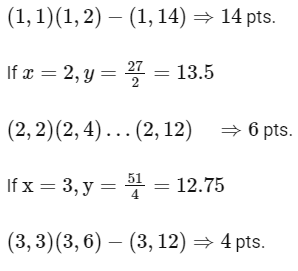

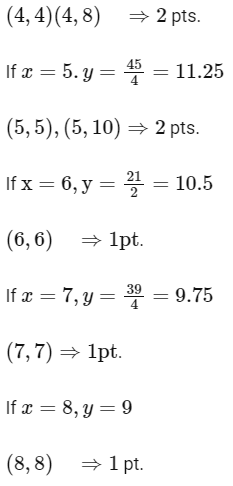

Total = 31pts.
Q43: Suppose Anil's mother wants to give 5 whole fruits to Anil from a basket of 7 red apples, 5 white apples and 8 oranges. If in the selected 5 fruits, at least 2 oranges, at least one red apple and at least one white apple must be given, then the number of ways, Anil's mother can offer 5 fruits to Anil is ____________.
Ans: 6860
Total 8 oranges, 5 white apple and 7 red apple. 5 fruits needs to be selected.
Case I: 3 orange + 1 red apple + 1 white apple
Case II: 2 oranges + 2 red apples + 1 white apple.
Case III: 2 oranges + 1 red apples + 2 white apple.
= 1960
Total = 1960 + 2940 + 1960
= 6860
Q44: Let x and y be distinct integers where 1 ≤ x ≤ 25 and 1 ≤ y ≤ 25 . Then, the number of ways of choosing x and y, such that x + y is divisible by 5, is ____________.
Ans: 120
Let x + y = 5λ Possible cases are Total number of ways = 20 + 25 + 25 + 25 + 25 = 120
Total number of ways = 20 + 25 + 25 + 25 + 25 = 120
Note: In first case total number of ways = 20 as in the question given that the chosen x and y are distinct integers each time.
So when you choose x as 5 then you can't choose y as 5. Possible values of y are (10, 15, 20, 25). So, here four possible pairs of (x, y) possible { (5, 10), (5, 15), (5, 20), (5, 25)}.
Similarly, four possible pairs of (x, y) possible each time when x = 10, 15, 20 and 25.
∴ Total number of ways in the first case = 5 × 4 = 20.
Q45: A boy needs to select five courses from 12 available courses, out of which 5 courses are language courses. If he can choose at most two language courses, then the number of ways he can choose five courses is __________
Ans: 546
Among 12 courses, 5 courses are of language.
∴ Remaining 7 are different courses.
Now, number of ways to select 5 courses where at most 2 language courses present.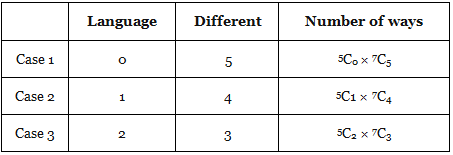 ∴ Total number of ways
∴ Total number of ways
= 546
Q46: The number of 9 digit numbers, that can be formed using all the digits of the number 123412341 so that the even digits occupy only even places, is ______________.
Ans: 60
Here, even digits are 2 and 4.
Number of digit "2" presents = 2
Number of digit "4" presents = 2
∴ Total even digits = 4 ∴ Total 4 even places presents.
∴ Total 4 even places presents.
Number of ways to put those 4 digits in those 4 places 
Now, remaining 5 digits (three 1 and two 3) can be put in those 5 places in
∴ Total possible 9 digit numbers
|
481 docs|964 tests
|
FAQs on JEE Main Previous Year Questions (2025): Permutations and Combinations - Chapter-wise Tests for JEE Main & Advanced
| 1. What is the difference between permutations and combinations in JEE Main? |  |
| 2. How can I determine the number of permutations of a set of objects in JEE Main? |  |
| 3. What is the concept of combinations and its application in JEE Main? |  |
| 4. How can I solve JEE Main questions related to permutations and combinations? |  |
| 5. Can permutations and combinations be applied to real-life scenarios? |  |
















